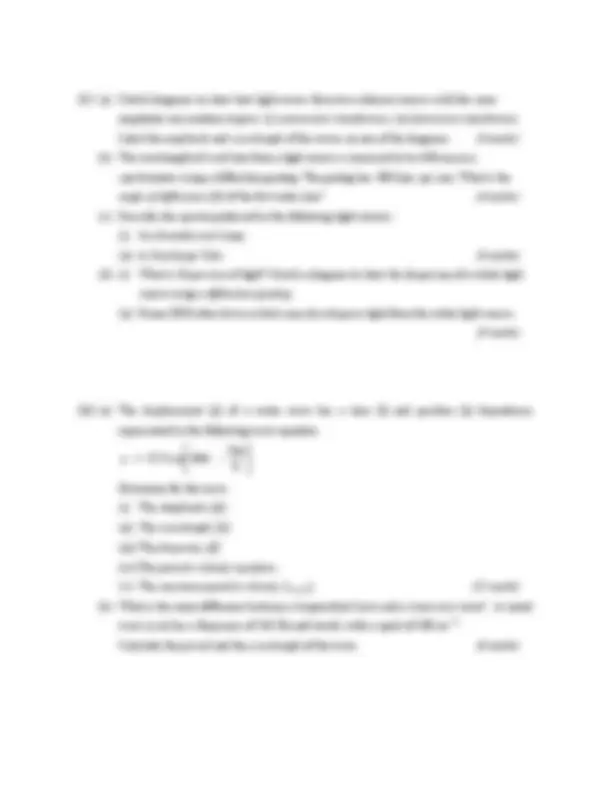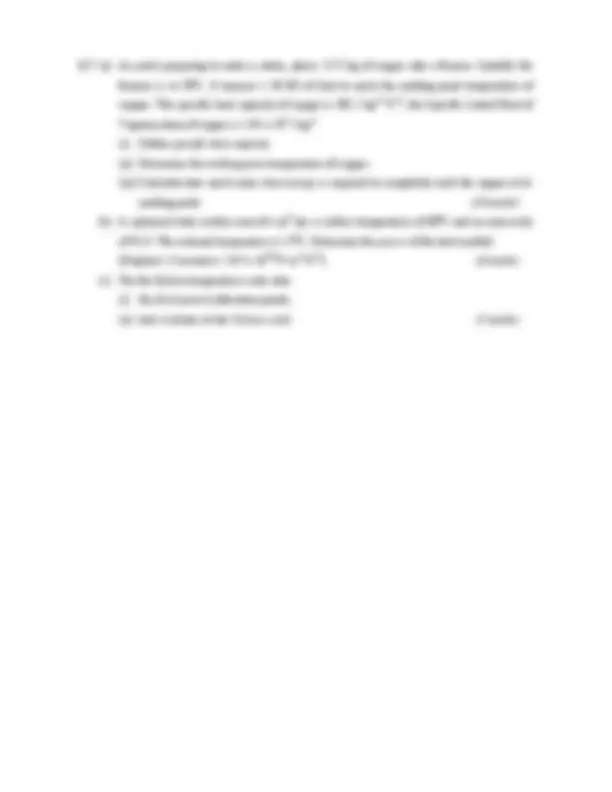




Study with the several resources on Docsity

Earn points by helping other students or get them with a premium plan


Prepare for your exams
Study with the several resources on Docsity

Earn points to download
Earn points by helping other students or get them with a premium plan
Community
Ask the community for help and clear up your study doubts
Discover the best universities in your country according to Docsity users
Free resources
Download our free guides on studying techniques, anxiety management strategies, and thesis advice from Docsity tutors
Main points of this past exam are: Kinetic Theory of Gases, Charles' Law, Volume of Bubble, Radius of Wire, Total Circuit Current, Power Dissipated, Refractive Index, Velocity of Light, Angle of Incidence, Diverging Lens
Typology: Exams
1 / 4

This page cannot be seen from the preview
Don't miss anything!



Answer (^) FIVE questions (^) only. Show ALL working to gain full marks. Assume: g = 10.0 ms -
Examiners: Mr. P. Anthony Prof. P. O Donoghue Dr. M.E. Woods
Q1. (a) State THREE assumptions of the Kinetic Theory of Gases. (3 marks)
(b) (i) State Charles' Law. (ii) Explain how a graphical plot of measurements taken to verify Charles' Law for an ideal gas leads to the concept of an Absolute Temperature Scale and Absolute Zero Temperature. What is the unit of the Absolute Temperature Scale? (6 marks) (c) An air bubble at the bottom of a lake 50 m deep has a volume of 1.00 cm^3. The temperature at the bottom is 7 o^ C and the surface is at 27 o^ C. [Atmospheric pressure is 1. x 10^5 Pa and the density of water is 1000 kg m-3^ .] (i) Calculate the total pressure at a depth of 50 m in the lake. (ii) Determine the volume of the bubble just as it reaches the surface. (11 marks)
Q2 (a) A copper cable of length 1.0 km and circular cross-section, has a resistance of 30 Ω. The resistivity of copper is 1.7 x 10-8^ Ω m. What is the radius of the wire? (6 marks) (b) A d.c. battery of emf 12.0 V is connected across three resistors R 1 , R 2 and R 3 connected in parallel: R 1 = 5 Ω, R 2 = 10 Ω, R 3 = 30 Ω. Determine: (i) the equivalent resistance [Re] of the three resistors; (ii) the power dissipated in R 1. (iii) the total circuit current I. (iv) The heat energy emitted by R 2 in 20 seconds. (14 marks)
Q3 (a) An object is embedded an apparent depth of 0.8 cm in a block of ice of refractive index 1.31. Determine: (i) the velocity of light in the ice [v]; (ii) the real depth of the embedded object in the ice. (6 marks) [The velocity of light in a vacuum, c = 3.00 x 10^8 ms-1^ ] (b) A beam of light propagates through diamond ( n 1 = 2.42) and strikes a diamond-air interface at an angle of incidence of 28º. Determine the critical angle for total internal reflection to occur. Hence state if part of the beam will enter the air ( n 2 = 1.00). (6 marks) (c) An object is placed 7 cm to the left of a diverging lens whose focal length is 5 cm. Find the image distance , determine whether the image is real or virtual and obtain the magnification of the image. (8 marks)
Q4 (a) Explain what is meant by heat transfer by: (i) Convection. (ii) Radiation. (4 marks) (b) Describe an example of a convection process and sketch a diagram to illustrate your description. (5 marks) (c) List THREE possible changes in the physical properties of a material when heat energy is supplied to it. (3 marks) (d) A plumber has neglected to lag the copper pipe leading from a hot water tank to a tap. The pipe has a surface area of 0.30 m^2 and a thickness of 6.0 mm. The inner surface of the pipe is at 80 o^ C and the outer surface is at 20 o^ C. The thermal conductivity of copper is 380 W m-1^ K -1^. Calculate the rate of heat loss by conduction through the pipe. (8 marks)
Q7 (a) An artist preparing to make a statue, places 3.75 kg of copper into a furnace. Initially the furnace is at 20o^ C. It requires 1.50 MJ of heat to reach the melting point temperature of copper. The specific heat capacity of copper is 381 J kg-1^ o^ C-1^ ; the Specific Latent Heat of Vapourisation of copper is 2.05 x 10^5 J kg -^. (i) Define specific heat capacity. (ii) Determine the melting point temperature of copper. (iii) Calculate how much more heat energy is required to completely melt the copper at its melting point. (10 marks) (b) A spherical body surface area 64 cm^2 has a surface temperature of 60 o^ C and an emissivity of 0.25. The external temperature is 15 o^ C. Determine the power of the heat emitted. [Stephan’s Constant is 5.67 x 10 -8^ W m-2^ K -4^ ]. (8 marks) (c) For the Kelvin temperature scale state: (i) the fixed point (calibration point); (ii) how it relates to the Celcius scale. (2 marks)